
Flowering plants are plants that bear flowers and fruits, and form the clade Angiospermae, commonly called angiosperms. They include all forbs, grasses and grass-like plants, a vast majority of broad-leaved trees, shrubs & vines, and most aquatic plants. The term "angiosperm" is derived from the Greek words ἀγγεῖον /angeion and σπέρμα / sperma ('seed'), meaning that the seeds are enclosed within a fruit. They are by far the most diverse group of land plants with 64 orders, 416 families, approximately 13,000 known genera and 300,000 known species. Angiosperms were formerly called Magnoliophyta.

The Arecaceae is a family of perennial, flowering plants in the monocot order Arecales. Their growth form can be climbers, shrubs, tree-like and stemless plants, all commonly known as palms. Those having a tree-like form are called palm trees. Currently, 181 genera with around 2,600 species are known, most of which are restricted to tropical and subtropical climates. Most palms are distinguished by their large, compound, evergreen leaves, known as fronds, arranged at the top of an unbranched stem. However, palms exhibit an enormous diversity in physical characteristics and inhabit nearly every type of habitat within their range, from rainforests to deserts.
Family is one of the eight major hierarchical taxonomic ranks in Linnaean taxonomy. It is classified between order and genus. A family may be divided into subfamilies, which are intermediate ranks between the ranks of family and genus. The official family names are Latin in origin; however, popular names are often used: for example, walnut trees and hickory trees belong to the family Juglandaceae, but that family is commonly referred to as the "walnut family". Sacca Vajje

The hobo spider is a member of the family of spiders known colloquially as funnel web spiders, but not to be confused with the Australian funnel-web spider. Individuals construct a funnel-shaped structure of silk sheeting and lie in wait at the small end of the funnel for prey insects to blunder onto their webs. Hobo spiders sometimes build their webs in or around human habitations. The hobo spider lays its eggs in September and they hatch during late spring. After the male hobo spider mates it dies.

Asarum is a genus of plants in the birthwort family Aristolochiaceae, commonly known as wild ginger.
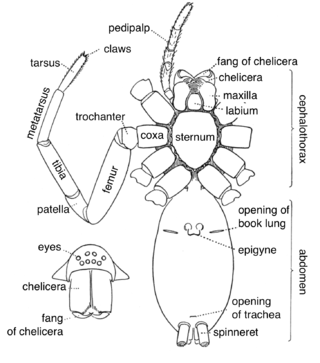
The epigyne or epigynum is the external genital structure of female spiders. As the epigyne varies greatly in form in different species, even in closely related ones, it often provides the most distinctive characteristic for recognizing species. It consists of a small, hardened portion of the exoskeleton located on the underside of the abdomen, in front of the epigastric furrow and between the epigastric plates.
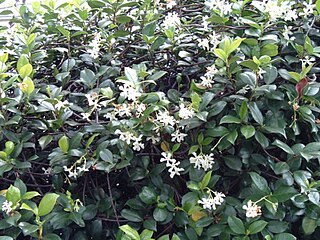
Trachelospermumstar jasmine, Confederate jasmine, is a genus of evergreen woody vines in the dogbane family Apocynaceae, first described as a genus in 1851. All species are native to southern and eastern Asia.
Gambaquezonia is a genus of the spider family Salticidae with two species. It was first described in some detail by Barrion & Litsinger (1995) from the female holotype, the only known specimen at the time. Its general appearance was later redescribed by Murphy and Murphy (2000).
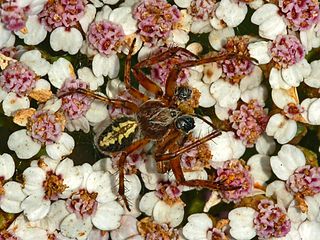
Aculepeira ceropegia, the oak spider, is an orb-weaving spider species belonging to the family Araneidae.
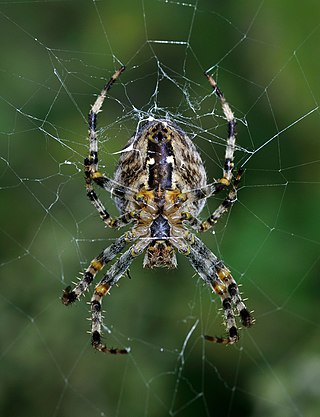
The Entelegynae or entelegynes are a subgroup of araneomorph spiders, the largest of the two main groups into which the araneomorphs were traditionally divided. Females have a genital plate (epigynum) and a "flow through" fertilization system; males have complex palpal bulbs. Molecular phylogenetic studies have supported the monophyly of Entelegynae.

Herennia is a genus of spiders in the family Araneidae, found from India to northern Australia. It was formerly placed in a separate family, Nephilidae. While two species have been known since the 19th century, nine new species were described in 2005. Spiders in this genus are sometimes called coin spiders.
Pimoa cthulhu is a species of the spider family Pimoidae. It is one of twenty-one described species in the genus Pimoa.
Epigynum auritum is a plant species in the genus Epigynum. It is native to Yunnan Province in China, as well as Assam State in India, Laos, Thailand, Myanmar (Burma), and the Peninsular region of Malaysia.
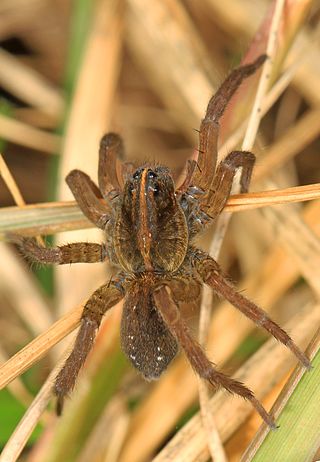
Tigrosa helluo is a species of spider belonging to the family Lycosidae, also known as wolf spiders. T. helluo was formerly known as Hogna helluo before differences between dorsal color patterns, habitat preferences, body structures, etc. were discovered. The species is native to the United States, Canada, and Mexico. It can be found across the eastern half of the United States, primarily in the Northeast and New England, and as far west as Nebraska and Kansas. T. helluo can be found in diverse habitats including woods, marshes, fields, and riparian areas. Typically, members of this species prefer to live in wetter areas as opposed to dry environments. Males tend to live for around a year and females will live for close to two years.

Pandava is a genus of araneomorph spiders in the family Titanoecidae.

Smeringopus pallidus, known as the pale daddy-long-leg, is a species of spider of the genus Smeringopus, family Pholcidae. It is a cosmopolitan species found in many countries.
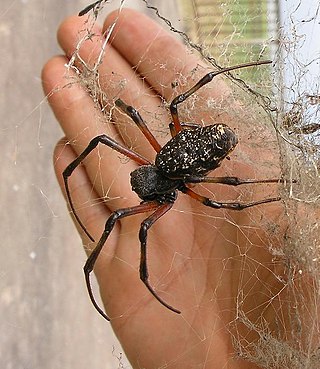
Nephilingis is a genus of spiders in the family Araneidae. It was split off from the genus Nephilengys in 2006. Both genera have been called hermit spiders from the habit of staying in their retreats during the day; alternatively the name "hermit spider" may be reserved for Nephilingis, with Nephilengys species called "eunuch spiders".
Centromerus cornupalpis is a species of sheetweb spider in the family Linyphiidae. It is found in the USA and Canada. This species exhibits sexual dimorphism. Males are identifiable by the shape of the cymbium, radix, and possession of a long proximo-dorsal horn on the paracymbium. Females exhibit a narrow, smooth constricted scape that originates anteriorly to the postero-lateral corners of the epigynum.
Micrathena lepidoptera a species of orb weaver in the family Araneidae. This species has been found in Costa Rica and Colombia and is endemic to Sierras Nevadas of northern Colombia. Not much is known about this species, including its diet, life cycle, and reproduction. A study by Ivan F. Magalhaes and Alberto J. Santos saw members of the Micrathena group genetically tested to better organize the Micrathena and Chaetacis phylogenetic trees. This paper includes four synapomorphies for this species. These include: wrinkled booklung covers, epigynum with a pair of anterior apodemes, small copulatory openings that are concealed beneath lateral plates, and terminal apophysis that is fused to the embolus. The females of this species are distinct by having three compound spines on the each side of the abdomen, with a thoracic depression and dimples in the carapace and blunt spines on either side of the spinnerets.












